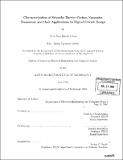| dc.contributor.advisor | Anantha Chandrakasan and Dimitri Antoniadis. | en_US |
| dc.contributor.author | Cline, Julia Van Meter, 1979- | en_US |
| dc.contributor.other | Massachusetts Institute of Technology. Dept. of Electrical Engineering and Computer Science. | en_US |
| dc.date.accessioned | 2005-09-26T20:43:51Z | |
| dc.date.available | 2005-09-26T20:43:51Z | |
| dc.date.copyright | 2004 | en_US |
| dc.date.issued | 2004 | en_US |
| dc.identifier.uri | http://hdl.handle.net/1721.1/28489 | |
| dc.description | Thesis (S.M.)--Massachusetts Institute of Technology, Dept. of Electrical Engineering and Computer Science, 2004. | en_US |
| dc.description | Includes bibliographical references (p. 106-109). | en_US |
| dc.description.abstract | The difficulty in shrinking silicon transistors past a certain feature size has been acknowledged for years. Carbon nanotubes (CNTs) offer a technology with an exciting solution to the scaling issues of transistors and interconnects and with the possibility of coexistence in the present silicon technology. The goal of the present work is to propose circuit models for carbon nanotube field effect transistors (CNTFETs) and apply them to aspects of digital circuit design. This research models the current voltage characteristics of CNTFETs below and above threshold. The current characteristics are similar to MIOSFETs, but with a few caveats. Under standard conditions, the devices do not enter saturation. Also. it is shown that CNTFETs are ambipolar devices, with a minimum current at V[sub]ds/2. Despite this distinction from MOSFETs, CNTFETs show impressive voltage transfer characteristics (VTC), even at low voltages. The large noise margin and notable output voltage swing can be traded-off for higher on-current, depending on the nanotube diameter, as shown in this work. Thus, digital designers have an ability to control both performance and power by changing the nanotube diameters. Carbon nanotubes FETs can become prominent in the arena of array devices, which are a technical front runner for the integration of wires and transistors. This work shows that carbon nanotube field effect transistors have strong potential in read only memory (ROM) arrays. Many CNTFETs can be placed along the length of a nanotube to create intermolecular devices and small array applications. The present process variations within carbon nanotubes lead to possible metallic CNTs and added redundancy. The necessary redundancy is illustrated in detail | en_US |
| dc.description.abstract | (cont.) in this thesis along with the corresponding trade-offs for redundancy, area, and performance. In conclusion, the striking properties of carbon nanotubes give CNTFET noteworthy IV characteristics and offer many opportunities for digital circuit designers in the near future. This thesis research models and characterizes the future opportunities of CNTFETs within digital designs. | en_US |
| dc.description.statementofresponsibility | by Julia Van Meter Cline. | en_US |
| dc.format.extent | 120 p. | en_US |
| dc.format.extent | 5883592 bytes | |
| dc.format.extent | 5898269 bytes | |
| dc.format.mimetype | application/pdf | |
| dc.format.mimetype | application/pdf | |
| dc.language.iso | en_US | |
| dc.publisher | Massachusetts Institute of Technology | en_US |
| dc.rights | M.I.T. theses are protected by copyright. They may be viewed from this source for any purpose, but reproduction or distribution in any format is prohibited without written permission. See provided URL for inquiries about permission. | en_US |
| dc.rights.uri | http://dspace.mit.edu/handle/1721.1/7582 | |
| dc.subject | Electrical Engineering and Computer Science. | en_US |
| dc.title | Characterization of Schottky barrier carbon nanotube transistors and their applications to digital circuit design | en_US |
| dc.type | Thesis | en_US |
| dc.description.degree | S.M. | en_US |
| dc.contributor.department | Massachusetts Institute of Technology. Department of Electrical Engineering and Computer Science | |
| dc.identifier.oclc | 57253810 | en_US |
